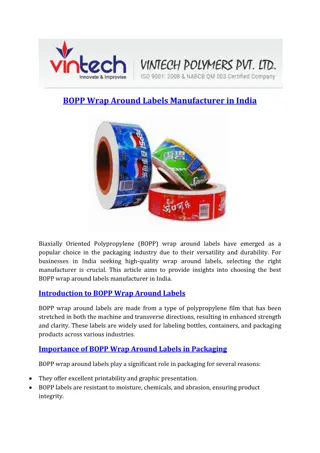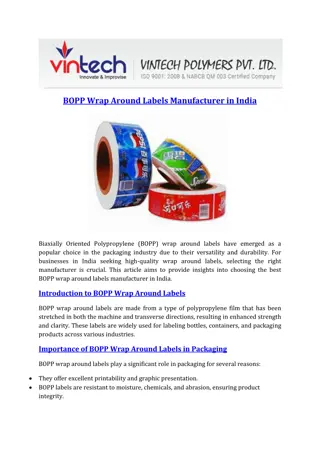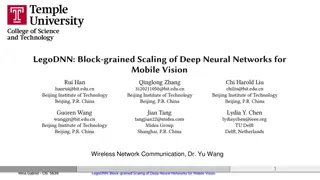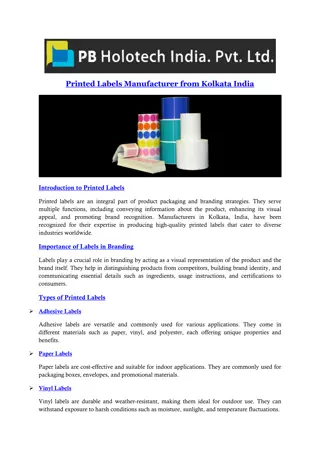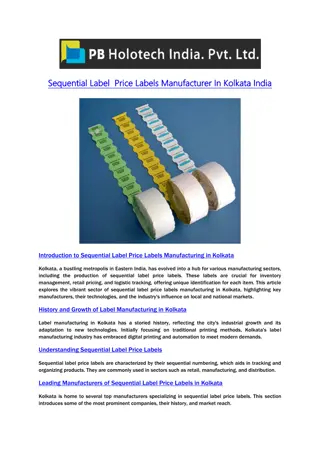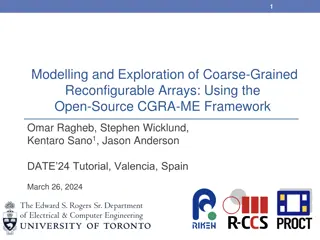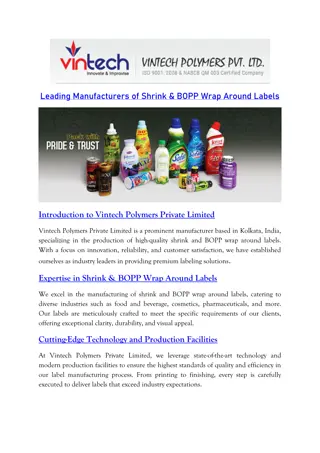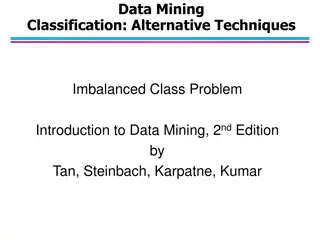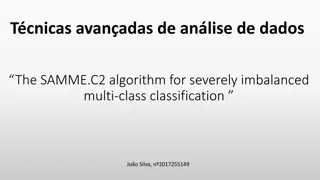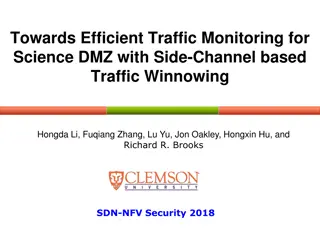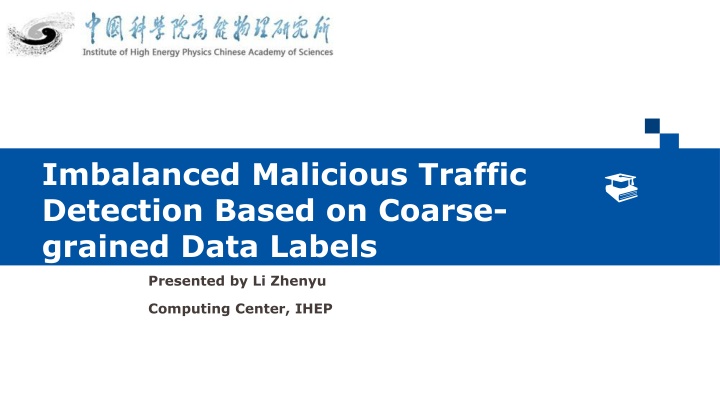
Imbalanced Malicious Traffic Detection Based on Coarse-grained Data Labels
This study focuses on detecting imbalanced malicious traffic through innovative methods, such as modeling the task as multi-instance learning to reduce data tagging costs. Researchers at IHEP Computing Center explore the use of emerging technologies like deep learning in cyber security to enhance network intrusion detection. The proposed approach aims to create a detection model that can effectively learn accurate labels in its characteristics real-world Target.
Download Presentation

Please find below an Image/Link to download the presentation.
The content on the website is provided AS IS for your information and personal use only. It may not be sold, licensed, or shared on other websites without obtaining consent from the author. If you encounter any issues during the download, it is possible that the publisher has removed the file from their server.
You are allowed to download the files provided on this website for personal or commercial use, subject to the condition that they are used lawfully. All files are the property of their respective owners.
The content on the website is provided AS IS for your information and personal use only. It may not be sold, licensed, or shared on other websites without obtaining consent from the author.
E N D
Presentation Transcript
Imbalanced Malicious Traffic Detection Based on Coarse- grained Data Labels Presented by Li Zhenyu Computing Center, IHEP
Background Key Technology 02 01 CONTENTS Result of Experiments Summary and Prospect 04 03
Background Background Cyber security is a necessary prerequisite for the normal operation of many scientific research and production service. Many scholars have carried out relevant explorations. IHEPSOC has studied and used many emerging technologies. In order to ensure cyber security, researchers have carried out a lot of researches in machine learning, especially in the field of deep learning. For example, Wang et al. [1] first proposed to use representation learning for traffic intrusion detection with CNN. And with the popularity of Transformer structure, Su et al. [2] also tried to combine BLSTM with Transformer. Many of the methods proposed have achieved excellent results. [1] Wang W, Zhu M, Zeng X, et al. Malware traffic classification using convolutional neural network for representation learning[C]//2017 International conference on information networking (ICOIN). IEEE, 2017: 712-717. [2] Su T, Sun H, Zhu J, et al. BAT: Deep learning methods on network intrusion detection using NSL-KDD dataset[J]. IEEE Access, 2020, 8: 29575-29585. 4 PPT www.1ppt.com/moban/ PPT www.1ppt.com/hangye/ PPT www.1ppt.com/jieri/ PPT www.1ppt.com/sucai/ PPT www.1ppt.com/beijing/ PPT www.1ppt.com/tubiao/ PPT www.1ppt.com/xiazai/ PPT www.1ppt.com/powerpoint/ Word www.1ppt.com/word/ Excel www.1ppt.com/excel/ www.1ppt.com/ziliao/ PPT www.1ppt.com/kejian/ www.1ppt.com/fanwen/ www.1ppt.com/shiti/ www.1ppt.com/jiaoan/ www.1ppt.com/ziti/
Problem Problem ONE Problem TWO Existing malicious traffic In actual network traffic detection methods are data, the proportion of mainly based on malicious traffic is often supervised methods, and it small, which makes it is difficult to obtain a large difficult for many AI amount of traffic data with models to effectively learn accurate labels in its characteristics real-world Target A detection model that does not require a lot of precious labels and is suitable for a imbalanced data distribution, which are very important for real-world scene and can save a lot of cost. 5 PPT www.1ppt.com/moban/ PPT www.1ppt.com/hangye/ PPT www.1ppt.com/jieri/ PPT www.1ppt.com/sucai/ PPT www.1ppt.com/beijing/ PPT www.1ppt.com/tubiao/ PPT www.1ppt.com/xiazai/ PPT www.1ppt.com/powerpoint/ Word www.1ppt.com/word/ Excel www.1ppt.com/excel/ www.1ppt.com/ziliao/ PPT www.1ppt.com/kejian/ www.1ppt.com/fanwen/ www.1ppt.com/shiti/ www.1ppt.com/jiaoan/ www.1ppt.com/ziti/
Proposed Methods Modeling as Multi-instance Learning In order to reduce the cost of data tagging, the malicious traffic detection task is modeled as a multi- instance learning (MIL) problem. Instead of labeling each data fine-grained, experts only need to label all the data in a time slice coarse-grained Pre-estimate the Positive Score Inspired by Carbonneau et al.[3], we use multiple clustering algorithms to pre-estimate the positive score of the coarse-grained labeled data from multiple sub-feature spaces, which will assist the MIL model to focus on true positive data with a small proportion Positive Score Adjustment We propose a method to dynamically adjust the positive score, which makes the MIL model more dominant in the prediction [3] Marc-Andr Carbonneau,Robust multiple-instance learning ensembles using random subspace instance selection,Pattern Recognition,Volume 58,2016. 6 PPT www.1ppt.com/moban/ PPT www.1ppt.com/hangye/ PPT www.1ppt.com/jieri/ PPT www.1ppt.com/sucai/ PPT www.1ppt.com/beijing/ PPT www.1ppt.com/tubiao/ PPT www.1ppt.com/xiazai/ PPT www.1ppt.com/powerpoint/ Word www.1ppt.com/word/ Excel www.1ppt.com/excel/ www.1ppt.com/ziliao/ PPT www.1ppt.com/kejian/ www.1ppt.com/fanwen/ www.1ppt.com/shiti/ www.1ppt.com/jiaoan/ www.1ppt.com/ziti/
Flow Chart clustering model sets clustering model sets clustering model K-means sets K-means 0.2 0.3 time slice 1 Mean Shift K-means ... ... ... Mean Shift 0.15 0.22 Mean Shift DBSCAN DBSCAN time slice 2 0.4 0.1 DBSCAN MIL Raw data with coarse- grained label Predictions 0.7 Neural Network Coarse-grained labeled data with pre-estimated score Update the pre-estimated score 7 PPT www.1ppt.com/moban/ PPT www.1ppt.com/hangye/ PPT www.1ppt.com/jieri/ PPT www.1ppt.com/sucai/ PPT www.1ppt.com/beijing/ PPT www.1ppt.com/tubiao/ PPT www.1ppt.com/xiazai/ PPT www.1ppt.com/powerpoint/ Word www.1ppt.com/word/ Excel www.1ppt.com/excel/ www.1ppt.com/ziliao/ PPT www.1ppt.com/kejian/ www.1ppt.com/fanwen/ www.1ppt.com/shiti/ www.1ppt.com/jiaoan/ www.1ppt.com/ziti/
Key Technology
Terms Instance 01 A cyber traffic data is called an instance. If the traffic data belongs to a malicious category, it is called a positive instance of that category, and if it does not belong to any malicious category, it is called a negative instance. Bag 02 A collection of instances is called a bag. If there is at least one positive instance in the bag, it is called a positive bag of corresponding category; otherwise, it is called a negative bag. The labels for instances are consistent with the bag. Multi-instance Learning(MIL) 03 MIL is one of weakly supervised learning. Compared with the supervised learning, the requirement of labels is reduced to the bag-level. The learning task of the model is to provide instance-level predictions with only bag-level coarse-grained labels. Imbalance Rate 04 The Imbalance Rate is the ratio of the minority category in a data set. In our problem, this concept refers to the ratio of positive instances in the positive bag. 9 PPT www.1ppt.com/moban/ PPT www.1ppt.com/hangye/ PPT www.1ppt.com/jieri/ PPT www.1ppt.com/sucai/ PPT www.1ppt.com/beijing/ PPT www.1ppt.com/tubiao/ PPT www.1ppt.com/xiazai/ PPT www.1ppt.com/powerpoint/ Word www.1ppt.com/word/ Excel www.1ppt.com/excel/ www.1ppt.com/ziliao/ PPT www.1ppt.com/kejian/ www.1ppt.com/fanwen/ www.1ppt.com/shiti/ www.1ppt.com/jiaoan/ www.1ppt.com/ziti/
Coarse-grained Labeling Note Legend The labels for instances are consistent with the bag We only know that there is at least one positive instance in the positive bag, but we do not know which one is the positive instance. Advantage Benign data (Negative instance) Malicious data(Positive instance) Label for negative bag/instance Label for positive bag/instance Significantly reduce the cost of labeling. Experts only need to capture the traffic data during the time slice of malicious operation in the simulation as a bag and label it as malicious, without knowing the specific malicious item. time slice 1 time slice 2 expert Traffic productor PPT www.1ppt.com/moban/ PPT www.1ppt.com/hangye/ PPT www.1ppt.com/jieri/ PPT www.1ppt.com/sucai/ PPT www.1ppt.com/beijing/ PPT www.1ppt.com/tubiao/ PPT www.1ppt.com/xiazai/ PPT www.1ppt.com/powerpoint/ Word www.1ppt.com/word/ Excel www.1ppt.com/excel/ www.1ppt.com/ziliao/ PPT www.1ppt.com/kejian/ www.1ppt.com/fanwen/ www.1ppt.com/shiti/ www.1ppt.com/jiaoan/ www.1ppt.com/ziti/ 10 Instances with bag-level label Cyber traffic
Loss Function Loss Function ? :Cross entropy function ??: Label of the bag ??: Value of the label for negative bag ??: Prediction of an instance PPT www.1ppt.com/moban/ PPT www.1ppt.com/hangye/ PPT www.1ppt.com/jieri/ PPT www.1ppt.com/sucai/ PPT www.1ppt.com/beijing/ PPT www.1ppt.com/tubiao/ PPT www.1ppt.com/xiazai/ PPT www.1ppt.com/powerpoint/ Word www.1ppt.com/word/ Excel www.1ppt.com/excel/ www.1ppt.com/ziliao/ PPT www.1ppt.com/kejian/ www.1ppt.com/fanwen/ www.1ppt.com/shiti/ www.1ppt.com/jiaoan/ www.1ppt.com/ziti/ 11
Pre-estimated the Positive Score Multiple clustering algorithms (K-means, Mean-shift, DBSCAN) are used for clustering in multiple subspaces. Each time, the pre-estimated score of a category in a cluster is the proportion of the instances with label of that category in the cluster, and the score of the instances in this cluster are consistent with the score of the cluster Note: This process is carried out many times in different subspace, each subspace will get different clustering results by using several clustering models, and the final pre-estimated score of an instance is calculated by the result in all the subspaces. A clustering result in a subspace 0.1 0.22 bag label = Scareware score of Adware = 0.67 0.22 0.67 bag label = Adware 0.2 0.22 ... score of Scareware = 0.1 score of Scareware = 0.22 score of Adware = 0.22 0.75 0.2 score of Adware = 0.2 score of Adware = 0.75 Instances with pre-estimate score bag label = Benign PPT www.1ppt.com/moban/ PPT www.1ppt.com/hangye/ PPT www.1ppt.com/jieri/ PPT www.1ppt.com/sucai/ PPT www.1ppt.com/beijing/ PPT www.1ppt.com/tubiao/ PPT www.1ppt.com/xiazai/ PPT www.1ppt.com/powerpoint/ Word www.1ppt.com/word/ Excel www.1ppt.com/excel/ www.1ppt.com/ziliao/ PPT www.1ppt.com/kejian/ www.1ppt.com/fanwen/ www.1ppt.com/shiti/ www.1ppt.com/jiaoan/ www.1ppt.com/ziti/ 12
Loss Function with Score ? :Cross entropy function Loss function with pre-estimated score ??: Label of the bag ??: Value of the label for negative bag ??: Prediction of an instance ??: The pre-estimate positive score of ?? instance The effect of the pre-estimated score Making the model focus on the instance with high probability of been positive, which reduces the impact of data imbalance. This process is similar to the weighting effect of supervised learning. Reducing the bias caused by a large number of negative instances in the positive bag, which can greatly avoid the MIL model get a local optimal in a wrong direction PPT www.1ppt.com/moban/ PPT www.1ppt.com/hangye/ PPT www.1ppt.com/jieri/ PPT www.1ppt.com/sucai/ PPT www.1ppt.com/beijing/ PPT www.1ppt.com/tubiao/ PPT www.1ppt.com/xiazai/ PPT www.1ppt.com/powerpoint/ Word www.1ppt.com/word/ Excel www.1ppt.com/excel/ www.1ppt.com/ziliao/ PPT www.1ppt.com/kejian/ www.1ppt.com/fanwen/ www.1ppt.com/shiti/ www.1ppt.com/jiaoan/ www.1ppt.com/ziti/ 13
Update Scheme Update the pre-estimated score When an Instance is predicted to be positive, its pre- estimated score should be increased in the next step, and conversely, its pre-estimated score should be decreased. We update the score through the following function: Effect of the updating Making the MIL model more dominant for the predictions, and only relies on the pre-estimated result of the clustering model in the early stage of training. PPT www.1ppt.com/moban/ PPT www.1ppt.com/hangye/ PPT www.1ppt.com/jieri/ PPT www.1ppt.com/sucai/ PPT www.1ppt.com/beijing/ PPT www.1ppt.com/tubiao/ PPT www.1ppt.com/xiazai/ PPT www.1ppt.com/powerpoint/ Word www.1ppt.com/word/ Excel www.1ppt.com/excel/ www.1ppt.com/ziliao/ PPT www.1ppt.com/kejian/ www.1ppt.com/fanwen/ www.1ppt.com/shiti/ www.1ppt.com/jiaoan/ www.1ppt.com/ziti/ 14
Result of Experiment
Setup Dataset Android Malware 2017 this dataset includes 5 categories of network traffic data, including Adware, Ransomeware, Scareware, SMSmalware and Benign, with about 4.67 million cyber traffic data Coarse-grained handle In the training set, data in Benign categories are randomly inserted into other categories to form positive bags, and labels of Benign are changed to other categories. The instance-level labels in bags are unreliable. Indicator We took AUC as the indicator of model performance (AUC takes TPR and FPR into account comprehensively, and the larger AUC value indicates the better model performance). There three experiments: imbalance rate experiment, compare experiment and ablation experiment. The ratio of training set and test set of all experiments were 80% and 20% . PPT www.1ppt.com/moban/ PPT www.1ppt.com/hangye/ PPT www.1ppt.com/jieri/ PPT www.1ppt.com/sucai/ PPT www.1ppt.com/beijing/ PPT www.1ppt.com/tubiao/ PPT www.1ppt.com/xiazai/ PPT www.1ppt.com/powerpoint/ Word www.1ppt.com/word/ Excel www.1ppt.com/excel/ www.1ppt.com/ziliao/ PPT www.1ppt.com/kejian/ www.1ppt.com/fanwen/ www.1ppt.com/shiti/ www.1ppt.com/jiaoan/ www.1ppt.com/ziti/ 16
Setup Environment Python 2.7 , Tensorflow 1.12, scikit-learn 0.24.1 Ubuntu 20.04 LTS OS NVIDIA Corporation Tesla T4 GPU PPT www.1ppt.com/moban/ PPT www.1ppt.com/hangye/ PPT www.1ppt.com/jieri/ PPT www.1ppt.com/sucai/ PPT www.1ppt.com/beijing/ PPT www.1ppt.com/tubiao/ PPT www.1ppt.com/xiazai/ PPT www.1ppt.com/powerpoint/ Word www.1ppt.com/word/ Excel www.1ppt.com/excel/ www.1ppt.com/ziliao/ PPT www.1ppt.com/kejian/ www.1ppt.com/fanwen/ www.1ppt.com/shiti/ www.1ppt.com/jiaoan/ www.1ppt.com/ziti/ 17
Imbalance Rate Experiment Purpose To study the influence of imbalance rate on the performance of the proposed model. Setup According to different imbalance rate, Benign data and malicious traffic are randomly mixed to form bags, all the other process are same. Result The performance increases significantly as the imbalance rate increases, The gains approaches convergence after the imbalance rate is greater than 1:20 PPT www.1ppt.com/moban/ PPT www.1ppt.com/hangye/ PPT www.1ppt.com/jieri/ PPT www.1ppt.com/sucai/ PPT www.1ppt.com/beijing/ PPT www.1ppt.com/tubiao/ PPT www.1ppt.com/xiazai/ PPT www.1ppt.com/powerpoint/ Word www.1ppt.com/word/ Excel www.1ppt.com/excel/ www.1ppt.com/ziliao/ PPT www.1ppt.com/kejian/ www.1ppt.com/fanwen/ www.1ppt.com/shiti/ www.1ppt.com/jiaoan/ www.1ppt.com/ziti/ 18
Compare Experiment Purpose To study the performance comparison between the proposed method and other supervised learning methods Setup Three methods are compared: CNN structure propos ed by Wang et al, SVM and HMM. The backbone neural network structure used in our method is the same as the CNN structure propose d by Wang et al. Result Compared with traditional machine learning algorithms, Our method achieves suboptimal performance under most categories. PPT www.1ppt.com/moban/ PPT www.1ppt.com/hangye/ PPT www.1ppt.com/jieri/ PPT www.1ppt.com/sucai/ PPT www.1ppt.com/beijing/ PPT www.1ppt.com/tubiao/ PPT www.1ppt.com/xiazai/ PPT www.1ppt.com/powerpoint/ Word www.1ppt.com/word/ Excel www.1ppt.com/excel/ www.1ppt.com/ziliao/ PPT www.1ppt.com/kejian/ www.1ppt.com/fanwen/ www.1ppt.com/shiti/ www.1ppt.com/jiaoan/ www.1ppt.com/ziti/ 19
Ablation Experiment Purpose In order to study the influence of different parts in the proposed method Setup Add the pre-estimated method and adjustment func tion for positive instances to MIL model one by one Result Each part of our method works well. PPT www.1ppt.com/moban/ PPT www.1ppt.com/hangye/ PPT www.1ppt.com/jieri/ PPT www.1ppt.com/sucai/ PPT www.1ppt.com/beijing/ PPT www.1ppt.com/tubiao/ PPT www.1ppt.com/xiazai/ PPT www.1ppt.com/powerpoint/ Word www.1ppt.com/word/ Excel www.1ppt.com/excel/ www.1ppt.com/ziliao/ PPT www.1ppt.com/kejian/ www.1ppt.com/fanwen/ www.1ppt.com/shiti/ www.1ppt.com/jiaoan/ www.1ppt.com/ziti/ 20
Summary and Prospect
Summary and Prospect Summary We try to explore a malicious traffic detection method under weakly supervised learning. We modeled malicious traffic detection as multi-instance learning problem. A pre-estimation and dynamic adjustment method for positive score is proposed to solve the imbalance problem. Every part works well. We achieved suboptimal performance. PPT www.1ppt.com/moban/ PPT www.1ppt.com/hangye/ PPT www.1ppt.com/jieri/ PPT www.1ppt.com/sucai/ PPT www.1ppt.com/beijing/ PPT www.1ppt.com/tubiao/ PPT www.1ppt.com/xiazai/ PPT www.1ppt.com/powerpoint/ Word www.1ppt.com/word/ Excel www.1ppt.com/excel/ www.1ppt.com/ziliao/ PPT www.1ppt.com/kejian/ www.1ppt.com/fanwen/ www.1ppt.com/shiti/ www.1ppt.com/jiaoan/ www.1ppt.com/ziti/ 22
Summary and Prospect Prospect Try some more cutting-edge models as the backbone models. Study the influence of distribution and correlation across multiple instances in a bag. Call for more work to turn to the weakly supervised learning field. PPT www.1ppt.com/moban/ PPT www.1ppt.com/hangye/ PPT www.1ppt.com/jieri/ PPT www.1ppt.com/sucai/ PPT www.1ppt.com/beijing/ PPT www.1ppt.com/tubiao/ PPT www.1ppt.com/xiazai/ PPT www.1ppt.com/powerpoint/ Word www.1ppt.com/word/ Excel www.1ppt.com/excel/ www.1ppt.com/ziliao/ PPT www.1ppt.com/kejian/ www.1ppt.com/fanwen/ www.1ppt.com/shiti/ www.1ppt.com/jiaoan/ www.1ppt.com/ziti/ 23


